Clean a 1911 – Cleaning Is a Crucial Part of Gun Maintenance
This article will explain step-by-step the most basic of gunsmithing skills, cleaning. Of the hundreds of guns I look at each year, 65% of them just need a good cleaning. I charge around $40 to do this simple procedure, but it can easily be done at home.
Cleaning is also the most CRUCIAL of all firearms maintenance procedures, as a good cleaning does two things: allows the user to identify any future problems BEFORE they happen, and keeps the gun running free of hang-ups and debris, which cause premature wear. Think of it as an oil change for your pistol. This is by no means a comprehensive breakdown, but it’s enough to keep a good pistol running.
What Is Field Stripping?
I have boiled it down to a tool free stripping so as to be done in the field, thus the term field stripping. Some folks clean a 1911 differently, like my friend who simply removes the barrel on his Glock, and throws the damned thing in the dishwasher. Bob swears that Glock OK’d the practice, and he’d know, being a certified Glock armorer and all. This tear down method works on all 1911 style pistols.
Safety Procedures for Gun Cleaning
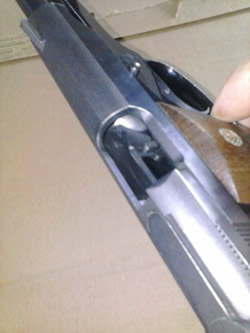
First, and always first is safety! Begin by dropping the magazine and clearing the chamber. Then, clear the magazine. NEVER should the two ever meet again during the cleaning process.
Depress Mag release button, and slide the magazine out of the mag well. Next, clear the chamber, rack back the slide, and lock it back using the slide catch. Confirm this is clear a MINIMUM of 3 times.
Check and clear the magazine. Also confirm 3 times, because most accidents occur when cleaning a gun especially when you clean a 1911.
Disassembling the 1911 Pistol
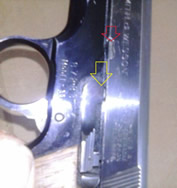
Now we are ready to disassemble our firearm. Note the slide catch and slide, there is a notch in the slide for the catch to push through and a button on the opposite side that pushes the slide catch through.
Line the notch up with the button, depress the button, and pull the slide catch out of the gun. For simplicity, I marked the notch with a red arrow, slide catch with a yellow arrow, and the button with an orange arrow in the next two pictures.
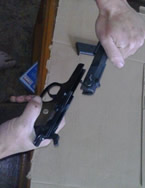
So, we lined up our notch, pushed our button and removed the slide catch. This may take some wiggling and finagling, but it is easily done after a few times of doing it.
Now, flipping the safety to the “OFF” position, we should be able to work our slide back and forth a time or two and the slide assembly will simply slide forward and off the gun, leaving us with two separate assemblies, slide and receiver, or frame. Set the receiver aside for now, and let’s concentrate on the slide at this time.
Removing the Recoil Spring and Guide Rod
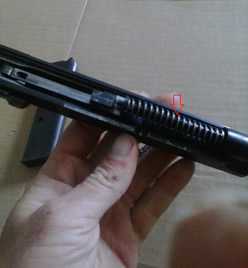
First and trickiest thing to come out is the recoil spring and guide rod. Exercise caution when removing these, as the spring can fly out.
This is the most powerful spring in the whole pistol – BE CAREFUL.
I often grab the slide as shown above with one hand and fish the spring and guide rod out as an assembly with the other to prevent this from happening.
Removing Barrel Bushing and Barrel of 1911 Pistol

Next thing scheduled for removal…. Barrel bushing. Some guns do not have a barrel bushing, if yours doesn’t, skip this step. Rotate the bushing 1/8 to ½ turn either clockwise or counter clockwise. This will vary from gun to gun.
The bushing is locked into place by the guide rod, and will NOT come out without the rod being removed. The barrel can’t come out of the slide without the bushing being removed, it keeps the barrel centered and tight in the slide. In the next picture, the barrel bushing is marked with a red arrow.
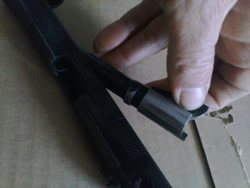
Next, the barrel should lift out and slide free of the slide toward the breech. I stick my finger through the ejection port on the slide. Then, give a gentle push up and slide the barrel back a little bit. Once unseated, the barrel just slides up and out from the breech of the slide.
With the completion of this step, field stripping is complete. We should have a series of components like in the picture below, ready for cleaning.

From left to right we have as follows: Magazine, Barrel, Slide catch, Slide, Barrel Bushing, Guide rod and Recoil spring, and receiver. We are now ready to clean our gun.
Clean a 1911 – Gun Cleaning Products and Tools
First, let’s discuss cleaning products and tools. There are literally TONS 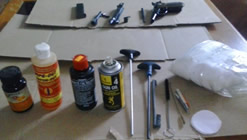 of cleaning products out there, but a lot of them are gimmicks designed to part you and your money. It’s really all about personal preference. Pictured below are a few of the cleaning solvents out there and some cleaning tools also.
of cleaning products out there, but a lot of them are gimmicks designed to part you and your money. It’s really all about personal preference. Pictured below are a few of the cleaning solvents out there and some cleaning tools also.
From left to right, Hoppe’s #9 solvent, Wipe-out Patch-out maximum strength solvent, Sweet’s 7.62 Solvent, Browning Aerosol gun oil, 2 cleaning rods, an action brush, 2 barrel brushes, a screw on barrel brush, a wool mop, a patch jag, cleaning patches, and a bulk bag of cleaning patches.
This is a LOT of crap to keep up with for the leisure shooter. I do a lot of shooting and repairing of guns, so it is necessary for me to have all this stuff. However, it is much simpler for the leisure shooter or casual gunner to have a simple kit, put out by several manufacturers. Just make sure you get the kit for the caliber gun you own!
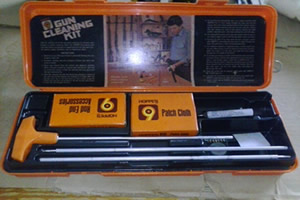
Just a word on some of these products, I only pictured ones I know to work. I am NOT recommending anyone go out and buy all this or any of this stuff, just my personal preference. The Hoppe’s #9 solvent works fine for day to day cleaning.
Wipe-out Patch-out is a good medium duty solvent. It claims to remove copper fouling, but I know better than that. It also claims there is no need for a bore brush, BS! It is a good, medium duty solvent, but it is neither of these claims.
The Sweet’s 7.62 Solvent is a good heavy duty solvent. It DOES remove copper fouling, as is evidenced by the green colored metal that comes out with the dirty patches when cleaning. It still requires brushing, but is a heavier solvent then the other two. If you use a heavy solvent, you then need to use a lighter solvent to remove the residue from the heavier solvent. (Basically, you Clean a 1911 a few times to get it cleaner and residue free.)
Barrel Cleaning
Now, onto the actual cleaning. Scrub the barrel first, as this is where 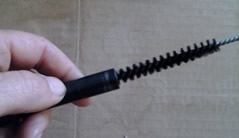 combustion takes place, and the copper jacketed bullet slides down the barrel. Almost all the abuse the gun takes occurs here. First, we take our solvent and a bore brush, soak the brush in solvent and commence scrubbing the barrel thoroughly.
combustion takes place, and the copper jacketed bullet slides down the barrel. Almost all the abuse the gun takes occurs here. First, we take our solvent and a bore brush, soak the brush in solvent and commence scrubbing the barrel thoroughly.
Clean guns are happy, reliable, more accurate guns. While cleaning, look for any dings at the crown of the muzzle, wear spots, or anything else that looks out of place or “beaten up”.
After bore brushing, we can start running patches down our bore and clean the outside of the barrel too.
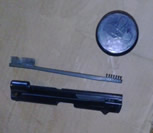
We get our patch jag and some patches and start swabbing. Do this until the patch comes out clean on the other end. If your patches don’t fit your bore, it is perfectly fine to cut them down to fit.
Once our barrel is cleaned, we shoot a light coat of oil on it and apply a light coat of oil to our bore mop. This mop is then run down the bore to apply oil and prevent rusting.
Cleaning the Slide, Recoil Spring, and Guide Rod of the 1911 Pistol
Next, move on to the slide itself. We take our action brush, or an old toothbrush and clean the slide thoroughly, looking for any defects in the slide as we do. Note: inspect the slide rails thoroughly.
After the slide and barrel are cleaned, they may be reassembled. Then we move on to the barrel bushing. A quick scrub with bore solvent makes quick work of this task and after oiling, it too can be re-installed.
Moving along to the recoil spring and guide rod. A patch soaked in solvent and threaded through the spring generally does the trick, same as a quick wipe down of the guide rod. After oiling, they can be re-installed. I sometimes use a rubber band to hold this assembly together whilst cleaning other parts of the gun. This completes the slide assembly half of the cleaning process.
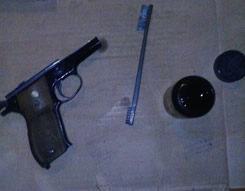
Now we move on to the action part of our cleaning job. We will not be disassembling the action for this job, as it is the field expedient version of it. You’ll need solvent, an action brush, or toothbrush, and your receiver.
Basically, just scrub the crap outta the receiver with your brush and plenty of solvent. Inspect all parts as you go, paying special attention to the action and the frame rails.
You may, if you wish remove the grips to keep the solvent off of them, however, since we are trying to do this without tools, you can forgo this part.
Finish Reassembling the 1911 Pistol
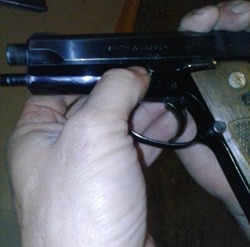
After cleaning and oiling, reassembly can begin. Don’t forget to give the slide catch a wipe down with a patch and some solvent.
Next slide the slide onto the receiver rails, breech first. You’ll have to push the trigger release and other parts downward to make it slide all the way back. Line up the notch on the slide with the slide catch pinhole.
Some pistols, particularly the M1911 family, have a lug that aligns the barrel inside the receiver and locks it in place with the slide catch pin. This can take some wriggling and “fiddling” with the gun, but align all holes and insert the slide catch pin.
After inserting the pin, make sure to mash it down hard and make sure it’s all the way home. You should at this time, have a re-assembled pistol.
Cleaning the 1911 Pistol Magazine
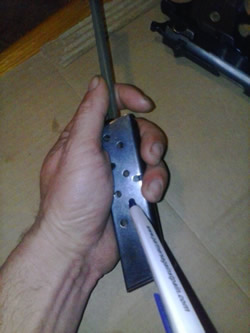
Now on to a commonly overlooked and difficult part of the gun to clean…… the mag. All you need is an action brush, solvent, and some patches. I often depress the follower and capture it through a hole in the mag with a pen or a stick to facilitate cleaning on the inside.
If you think about it, the mag is where a LOT of contamination happens. They get dropped in the dirt, stepped on, rattled around under truck seats, etc. and then crammed into the mag well and expected to perform. SCRUB THE HELL OUT OF YOUR MAGAZINES – inside and out!
Reloading and Securing
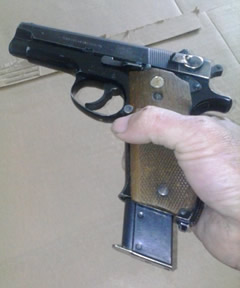
After cleaning the magazine, it is ready to be reloaded. An empty magazine or gun in a firefight is a STICK! Unless there are children in the house, I recommend leaving the firearms loaded and locked up. You never know when you will need them.
Mine all live securely in a gun safe. Actually, a few gun safes and one has a quick action biometric lock for emergencies. The gun is now ready to shoot again or for storage. This is how we expediently fieldstrip and clean our 1911 pistols. Keep them barrels warm.

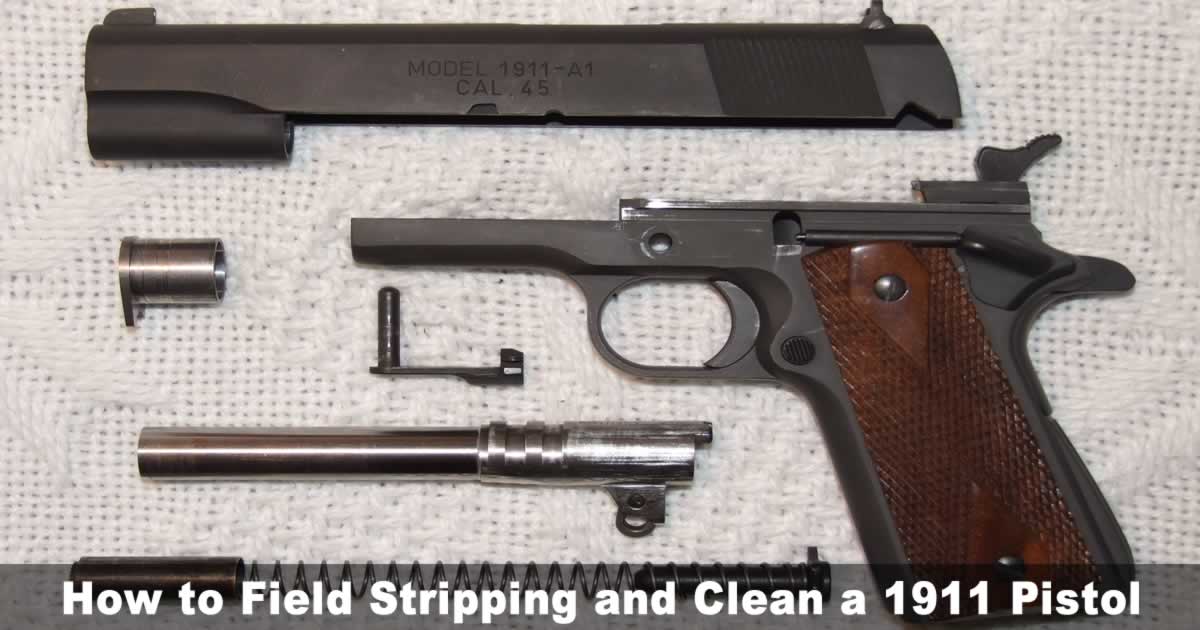
Leave a Reply